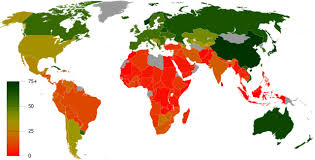In the global mobility space, we are all about people, aren’t we? We arrange for the right talent to be in the right place at the right time. We manage their relocation, support their family concerns, and help them get to a place where they can thrive and contribute to the company’s success as well as their own.
There are times when we eat, sleep, and dream about far-flung assignees. Sometimes this translates to our families at home. Last night my son was curious about world populations, and did some quick research on his own. Maybe you will be as surprised as he was about some of his interesting findings.
First, you should know that we live in the northeastern United States, in our country’s fifth most densely populated state: Connecticut. My son was surprised to learn that North Americans make up only about 8% of the world’s population. Not surprisingly, Asians account for some 60%.
Many of us can probably name most of the 10 most populous countries. They are China, India, the United States, Indonesia, Brazil, Pakistan, Nigeria, Bangladesh, Russia, and Japan. Their combined populations are over 4.2 billion – or 58% of the world’s nearly 7.3 billion people.
Only two of those 10 are also included in the 10 most densely populated countries: India and Japan. When I first started in this industry 18 years ago, and worked on our Canada content, I was surprised to learn that our dear neighbors to the north populate a country that is about 10% larger than the U.S. but home to 90% fewer people. (In case you were wondering who has more space than Canadians, Greenland has the lowest population density, with .069 people per square mile. )
And how about male/female ratios? In total, the number of men and women is nearly even, with slightly more men in the world. But there are local anomalies. According to WolframAlpha, Susanville, California has the smallest percentage of female residents in the U.S. – only 34%. (Isn’t it ironic that the town is called Susanville and not – for example – Bartstown?) In five of those top 10 population countries above, only China and India are home to more men than women; the U.S., Indonesia, and Brazil all have higher female populations than male.
For those of you fellow data geeks who might like to investigate further on your own, here are some interesting sites:
Population Reference Bureau (PRB): http://www.prb.org/
United Nations Population Information Network (POPIN): http://www.un.org/popin/
U.S. Census Bureau Population Clock: http://www.census.gov/popclock/
Wolfram Alpha: http://www.wolframalpha.com
And, if you are ever feeling like a mere drop of water in a wide population ocean, always remember: You’re unique, just like everybody else!
By Ellen Harris – International Product Director, Living Abroad


